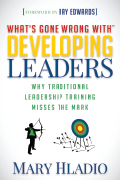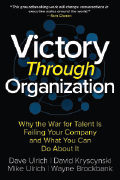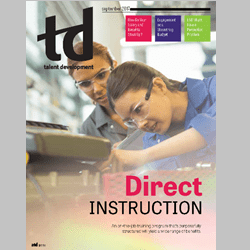TD Magazine Article
Engagement and Culture, With a Dash of Leadership Development
A review of Developing Leaders: Why Traditional Leadership Training Misses the Mark by Mary Hladio
Fri Sep 01 2017
Developing Leaders: Why Traditional Leadership Training Misses the Mark

By Mary Hladio
Morgan James Publishing, 178 pp., $29.95
Hladio lays the foundation for her book in its introduction, where she writes about how employee engagement results from leaders who are taught to effectively develop their teams. Her belief is clear: Culture is the main reason we need a new approach to leadership development.
Developing Leaders is segmented into three parts that each include several chapters, giving it 14 in total.
In part one, "Why Most Leadership Development Doesn't Work," Hladio explores the idea of focusing on development instead of training. In addition, she highlights the importance of tailoring training to a specific organizational problem or problems versus using a one-size-fits-all model. The section also covers why common training topics, such as managing change, time, and stress, are not beneficial for developing leaders.
In part two, "The Consequences of Taking the Wrong Approach to Development," Hladio delves into the negative outcomes companies face when they refuse to update their approach to developing people. She shares her thoughts on why training initiatives focused on topics such as effective communication, conflict management, and improvement of employee satisfaction are "unmanageable" and should not be focused on broadly. The rest of this section covers the emotional, productivity, and financial "costs" associated with an antiquated approach to employee development.
In the final segment of her book, "Learn to FUEL Your Organization to the Next Level," Hladio introduces the FUEL (find, utilize, engage, lead) process, which relates back to the themes highlighted throughout the text. Experienced talent development practitioners may note similarities between this process and a needs analysis.
Generally, the book is well-organized, and usually supports itself with credible examples, data, and research. Sources include other notable authors as well as studies from Gallup and the Society for Human Resource Management. Developing Leaders is rich with applicable, evidence-based solutions that make it easy for readers to revise current development programs for a more tailored approach.
While this book has many areas of strength, it also has a few that could be improved. For instance, the book's title is not congruent with the content, as Hladio focuses more on development of employees, improving engagement, and building a culture within an organization than on developing leaders. Furthermore, some readers might perceive the use of Wikipedia as a source throughout the book as discreditable.
In summation, this book is an adequate read for talent and organizational development professionals who are interested in improving the way their organizations handle engagement, training, and culture. However, it is a bit lighter on leadership development than the title would lead you to believe.
Sense and Respond: How Successful Organizations Listen to Customers and Create New Products Continuously

Jeff Gothelf and Josh Seiden
Harvard Business Review Press, 256 pp., $32
To Gothelf and Seiden, digital communication has changed the conversations companies should have with their markets, but managers aren't listening. Instead of partaking in two-way communication with customers to learn about them and adapt to their needs, many leaders stick to management techniques invented in the 20th century. If you agree, preparing managers at your organization to embrace an update may be less difficult after reading Sense and Respond. It shows how companies find value in learning about their customers, discusses how to become a more collaborative organization, and offers guidance on instilling a customer-sensing culture of learning in your work environment.
Victory Through Organization: Why the War for Talent Is Failing Your Company and What You Can Do About It

Dave Ulrich, Mike Ulrich, David Kryscynski, and Wayne Brockbank
McGraw Hill Education, 304 pp., $35
Are you a trainer or instructional designer who wants to map the competencies for your company's next-generation HR professional? Are you an organizational design guru who believes the system you create, more than the people you put in it, will determine your firm's success? If so, you will enjoy Victory Through Organization. After discussing why conventional HR methods often lead to mediocrity, the authors examine high-priority HR practices for the 21st century. These include information management, new means of employee performance management, and analytics. Then, the authors profile the different types of HR professionals that companies will need to succeed in the future, which can be useful for self-reflection.
Total Alignment: Tools and Tactics for Streamlining Your Organization

Robert Barner and Ken Ideus
Emerald Publishing, 240 pp., $40
Many professional coaches simply advise their clients, dictating how to avoid negative behaviors in specific situations. Some go deeper, encouraging self-reflection and insight that enable clients to determine their own paths forward. However, a small minority gets to the bottom of coaching. These individuals drive transformational learning, persuading clients to reconsider the stories they've constructed about the world and themselves. If you're thirsting for a book that can help you join that privileged few, then Working Deeply, which covers everything from how to use your own experiences while you coach to avoiding problematic labels for your clients, will leave you satisfied.
What's on Sharon Wingron's Bookshelf?
The 7 Habits of Highly Effective People: Powerful Lessons in Personal Change by Stephen R. Covey. This classic was monumental in my discovery of self, clarifying my values, developing my personal mission statement, transitioning me into this profession, and setting in motion the plans and habits for the life I now lead. It is a timeless guide for how to be a productive, successful person.
Yoga for Equestrians: A New Path for Achieving Union with the Horse by Linda Benedik and Veronica Wirth. I have a Missouri fox trotter horse that I trail ride, and I've been interested in practicing yoga for the health and fitness benefits—so this book intrigued me. I haven't started reading it yet; I'm hopeful it will benefit both my horse and me.
The Life-Changing Magic of Tidying Up: The Japanese Art of Decluttering and Organizing by Marie Kondo. My husband of eight years and I recently moved across the state of Missouri—along with our horse, pony, dog, and cat. When we got married, we combined households but didn't purge much. The time has come. I love Kondo's concept of only keeping items that give you joy. This is especially important since we work from home. I'm feeling more joy with each box I donate or take to the recycling center.

